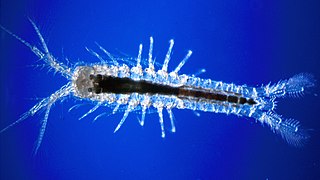Mesonerilla prospera is a species of invertebrate in the Nerillidae family endemic to Bermuda. In 2000, M. prospera was put on the IUCN Red List under the critically endangered category. The IUCN states that "there are problems with the Order name and the correct placement of the family."
Atlantasellus is a genus of crustaceans, and the only member of the family Atlantasellidae. It contains these species:
Barbouria is a genus of shrimp in the family Barbouriidae, comprising two species.
Arubolana aruboides is a species of crustacean in the family Cirolanidae. It is endemic to Bermuda.
Bermudamysis speluncola is a species of crustacean in the family Mysidae, endemic to Bermuda, and the only species in the genus Bermudamysis.
Bermudagidiella bermudiensis is a species of crustacean in the family Bogidiellidae. It is the only species in the genus Bermudagidiella, and is endemic to Bermuda.
Cocoharpinia iliffei is a species of crustacean in the family Phoxocephalidae. It is endemic to Bermuda.
Curassanthura bermudensis is a species of isopod crustacean in the family Leptanthuridae, endemic to Bermuda. It was described in 1985 by Johann Wägele and Angelika Brandt on the basis of a single immature specimen. This holotype specimen, which is 3 millimetres (0.12 in) long, was collected from Church Cave in Hamilton Parish, Bermuda, and is now stored at the Zoological Museum Amsterdam.
Erebonectes is a genus of crustacean in family Epacteriscidae, containing two troglobitic species. E. nasioticus was discovered in Bermuda and described in 1985; it is listed as critically endangered on the IUCN Red List. E. macrochaetus was found on Middle Caicos and described in 1994.
Idunella sketi is a species of crustacean in family Liljeborgiidae. It is endemic to Bermuda.
Ingolfiella longipes is a species of amphipod crustacean in the family Ingolfiellidae. It is known from a single specimen held at the Naturalis Biodiversity Center. It was collected from Walsingham Sink Cave, an anchialine cave in Hamilton Parish, Bermuda, and is thus considered to be critically endangered.

Mictocaris halope is the only species of cave crustacean in the monotypic genus Mictocaris. It is placed in its own family, Mictocarididae, and is sometimes considered the only member of the order Mictacea. Mictocaris is endemic to anchialine caves in Bermuda, and grows up to 3.5 mm (0.14 in) long. Its biology is poorly known.
Platyops sterreri is a species of crustacean in the family Mysidae, endemic to Bermuda, the only species in the genus Platyops.
Parhippolyte sterreri is a species of marine decapod crustacean in the family Barbouriidae, formerly placed in the genus Somersiella. It is found in marine caves around the Bahamas, Cuba and Mexico and inland anchialine caves in Bermuda.
Spelaeoecia is a genus of crustaceans in the family Thaumatocyprididae. One species, the Bermudan endemic S. bermudensis, is listed as critically endangered on the IUCN Red List. It contains the following species:
Speleophria bivexilla is a species of copepod in the family Speleophriidae. It is endemic to Bermuda.
Speleophria is a genus of marine copepods in the family Speleophriidae. It contains the following species:

Typhlatya is a genus of shrimp in the family Atyidae. These are small, stygobitic shrimp found in the West Mediterranean region, Caribbean region, Ascension Island and the Galápagos, although the individual species often have very small ranges. Species in this genus are found in salt, brackish and fresh waters, mostly in anchialine habitats and none in the open sea.

Platycopiidae is a family of copepods. Until the description of Nanocopia in 1988, it contained the single genus Platycopia. It now contains four genera, three of which are monotypic; the exception is Platycopia, with 8 species.
Speleophriidae is a family of copepods, comprising seven genera. All are restricted to anchialine caves, with the exception of Archimisophria, which is found in the hyperbenthos of the depths of the Atlantic Ocean. The genera are:



